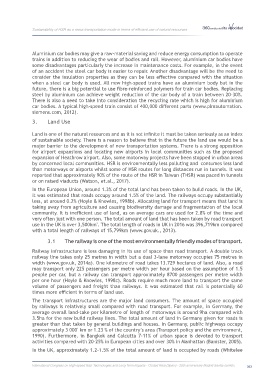Page 395 - 360.revista de Alta Velocidad - Nº 6
P. 395
Sustainability of HSR as a mass transportation mode in terms of efficient use of natural resources
Aluminium car bodies may give a raw-material saving and reduce energy consumption to operate
trains in addition to reducing the wear of bodies and rail. However, aluminium car bodies have
some disadvantages particularly the increase in maintenance costs. For example, in the event
of an accident the steel car body is easier to repair. Another disadvantage will be the need to
consider the insulation properties as they can be less effective compared with the situation
when a steel car body is used. All new high-speed trains have an aluminium body but in the
future, there is a big potential to use fibre-reinforced polymers for train car bodies. Replacing
steel by aluminium can achieve weight reduction of the car body of a train between 20-30%.
There is also a need to take into consideration the recycling rate which is high for aluminium
car bodies. A typical high-speed train consist of 400,000 different parts (www.plmautomation.
siemens.com, 2012).
3. Land Use
Land is one of the natural resources and as it is not infinite it must be taken seriously as an index
of sustainable society. There is a reason to believe that in the future the land use would be a
major barrier to the development of new transportation systems. There is a strong opposition
for airport expansions and locating new airports in local communities such as the proposed
expansion of Heathrow airport. Also, some motorway projects have been stopped in urban areas
by concerned local communities. HSR is environmentally less polluting and consumes less land
than motorways or airports whilst some of HSR routes for long distances run in tunnels. It was
reported that approximately 90% of the route of the HSR in Taiwan (THSR) was paced in tunnels
or on raised viaducts (Watson, et.al., 2017).
In the European Union, around 1.3% of the total land has been taken to build roads. In the UK,
it was estimated that roads occupy around 1.5% of the land. The railways occupy substantially
less, at around 0.2% (Hoyle & Knowles, 1998b). Allocating land for transport means that land is
taking away from agriculture and causing biodiversity damage and fragmentation of the local
community. It is inefficient use of land, as on average cars are used for 2.8% of the time and
very often just with one person. The total amount of land that has been taken by road transport
use in the UK is over 3,500km . The total length of roads in UK in 2016 was 396,719km compared
²
with a total length of railways of 15,799km (www.gov.uk., 2013).
3.1 The railway is one of the most environmentally friendly modes of transport.
Railway infrastructure is less damaging in its use of space than road transport. A double track
railway line takes only 25 metres in width but a dual 3-lane motorway occupies 75 metres in
width (www.gov.uk, 2014a). One kilometre of road takes 13.729 hectares of land. Also, a road
may transport only 225 passengers per metre width per hour based on the assumption of 1.5
people per car, but a railway can transport approximately 8700 passengers per metre width
per one hour (Hoyle & Knowles, 1998c). Roads require much more land to transport the same
volume of passengers and freight than railways. It was estimated that rail is potentially 60
times more efficient in terms of land use.
The transport infrastructures are the major land consumers. The amount of space occupied
by railways is relatively small compared with road transport. For example, in Germany, the
average overall land-take per kilometre of length of motorways is around 9ha compared with
3.5ha for the new build railway lines. The total amount of land in Germany given for roads is
greater than that taken by general buildings and houses. In Germany, public highways occupy
approximately 3 000 km or 1.23 % of the country’s area (Transport policy and the environment,
²
1990). Furthermore, in Bangkok and Calcutta 7-11% of urban space is devoted to transport
activities compared with 20-25% in European cities and over 30% in Manhattan (Banister, 2005).
In the UK, approximately 1.2-1.5% of the total amount of land is occupied by roads (Whitelee
International Congress on High-speed Rail: Technologies and Long Term Impacts - Ciudad Real (Spain) - 25th anniversary Madrid-Sevilla corridor 393

